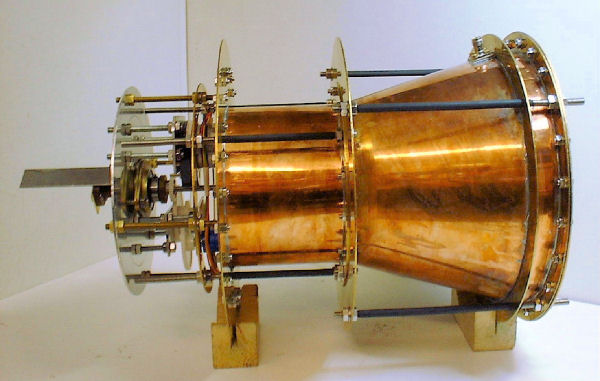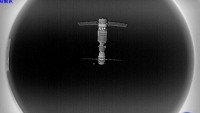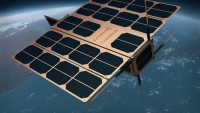Published NASA Study Confirms the EmDrive Works as Advertised
| Arthur Dominic Villasanta | | Nov 20, 2016 07:14 AM EST |
(Photo : Roger Sawyer) The concept of an EmDrive engine is relatively simple. It provides thrust to a spacecraft by bouncing microwaves around in a closed container.
Roger Shawyer's controversial EmDrive engine does indeed work, and a recently published study by a team of NASA engineers prove this resonant cavity thruster that violates fundamental laws of physics might one day be mankind's ticket to interstellar travel.
Proof was provided in a study published in the just released December issue of the "AIAA Journal of Propulsion and Power" with the title "Measurement of Impulsive Thrust from a Closed Radio Frequency Cavity in Vacuum." The journal is published by the American Institute of Aeronautics and Astronautics (AIAA).
Like Us on Facebook
The study was conducted by the Advanced Propulsion Physics Laboratory at NASA's Johnson Space Center, also known as "Eagleworks," and passed peer review before publication in the AIAA journal.
It suggests EmDrive or Em Drive (electromagnetic drive) technology apparently works. Its authors are Harold White, Paul March, Lawrence, Vera, Sylvester, Brady and Bailey.
The published NASA EmDrive paper confirms a NASA test EmDrive engine generated 1.2 millinewtons per kilowatt of thrust, which is 300 times better than other zero propellant propulsion systems
NASA's EmDrive tests consistently measured performance at 1.2 ± 0.1 mN/kW, which was very close to the average impulsive performance measured in air. A number of error sources were considered and discussed.
NASA concluded the EmDrive is 300 times more powerful than light sails, laser propulsion and photon rockets in thrust to power level basis
The EmDrive's 1.2 mN/kW performance parameter is over two orders of magnitude higher than other forms of zero propellant propulsion, such as light sails, laser propulsion, and photon rockets having thrust-to-power levels in the 3.33-6.67 µN/kW (or 0.0033-0.0067 mN/kW) range.
Also called a radio frequency (RF) resonant cavity thruster, an EmDrive is an electromagnetic thruster that uses no reaction mass and emits no directional radiation. Skeptics have long said the design principles of this machine aren't supported by prevailing scientific theories and violate the law of conservation of momentum.
Aerospace engineer Roger Shawyer designed the EM Drive in 2001 and has promoted the idea through his company, Satellite Propulsion Research. While considered implausible, the EmDrive stands to revolutionize many propulsion applications, especially those used in spaceflight.
The EmDrive has been dismissed many times as "impossible" because it appears to violate Newton's Third Law of Motion, which states that for every action there is an equal and opposite reaction.
The NASA EmDrive in the paper consists of a closed copper cone, the inside of which is being bombarded with microwaves. To test the EmDrive, the researchers powered it with 40, 60, and 80 watts and found that it generated up to 58, 128, and 119 micronewtons of thrust, respectively.
TagsEmDrive, Roger Shawyer, NASA, Measurement of Impulsive Thrust from a Closed Radio Frequency Cavity in Vacuum, Advanced Propulsion Physics Laboratory, Eagleworks
©2015 Chinatopix All rights reserved. Do not reproduce without permission
EDITOR'S PICKS
-

Did the Trump administration just announce plans for a trade war with ‘hostile’ China and Russia?
-

US Senate passes Taiwan travel bill slammed by China
-

As Yan Sihong’s family grieves, here are other Chinese students who went missing abroad. Some have never been found
-

Beijing blasts Western critics who ‘smear China’ with the term sharp power
-

China Envoy Seeks to Defuse Tensions With U.S. as a Trade War Brews
-

Singapore's Deputy PM Provides Bitcoin Vote of Confidence Amid China's Blanket Bans
-

China warns investors over risks in overseas virtual currency trading
-

Chinese government most trustworthy: survey
-

Kashima Antlers On Course For Back-To-Back Titles
MOST POPULAR
LATEST NEWS
Zhou Yongkang: China's Former Security Chief Sentenced to Life in Prison

China's former Chief of the Ministry of Public Security, Zhou Yongkang, has been given a life sentence after he was found guilty of abusing his office, bribery and deliberately ... Full Article
TRENDING STORY

China Pork Prices Expected to Stabilize As The Supplies Recover

Elephone P9000 Smartphone is now on Sale on Amazon India

There's a Big Chance Cliffhangers Won't Still Be Resolved When Grey's Anatomy Season 13 Returns

Supreme Court Ruled on Samsung vs Apple Dispute for Patent Infringement

Microsoft Surface Pro 5 Rumors and Release Date: What is the Latest?













